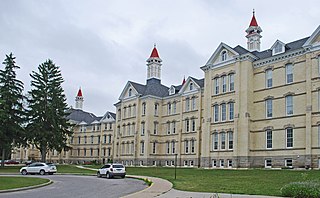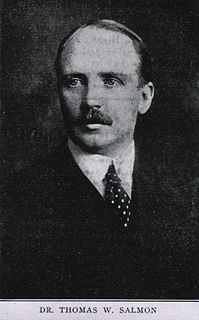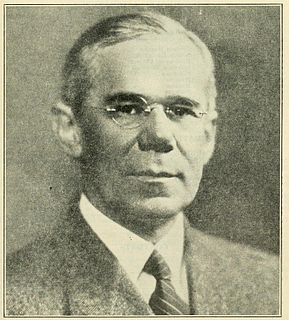Related Research Articles

Psychiatric hospitals, also known as mental health units or behavioral health units, are hospitals or wards specializing in the treatment of severe mental disorders, such as schizophrenia, bipolar disorder, and major depressive disorder. Psychiatric hospitals vary widely in their size and grading. Some hospitals may specialize only in short-term or outpatient therapy for low-risk patients. Others may specialize in the temporary or permanent containment of patients who need routine assistance, treatment, or a specialized and controlled environment due to a psychiatric disorder. Patients often choose voluntary commitment, but those whom psychiatrists believe to pose significant danger to themselves or others may be subject to involuntary commitment and involuntary treatment. Psychiatric hospitals may also be called psychiatric wards/units when they are a subunit of a regular hospital.

Thomas Story Kirkbride was a physician, alienist, hospital superintendent for the Institute of the Pennsylvania Hospital, and primary founder of the Association of Medical Superintendents of American Institutions for the Insane (AMSAII), the organizational precursor to the American Psychiatric Association. Along with Dr. Benjamin Rush he is considered to be the father of the modern American practice of psychiatry as a specific medical discipline. His directive and organization of institutions for the insane were the gold-standard of clinical care in psychiatry throughout the 19th century.

Isaac Ray was an American psychiatrist, one of the founders of the discipline of forensic psychiatry. In 1838, he published A Treatise on the Medical Jurisprudence of Insanity (Boston), which served as an authoritative text for many years.
The Association of Medical Superintendents of American Institutions for the Insane, also known as The Superintendents' Association, was organized in Philadelphia in October, 1844 at a meeting of 13 superintendents, making it the first professional medical specialty organization in the U.S.
Loren Richard Mosher was an American psychiatrist, clinical professor of psychiatry, expert on schizophrenia and the chief of the Center for Studies of Schizophrenia in the National Institute of Mental Health (1968–1980). Mosher spent his professional career advocating for humane and effective treatment for people diagnosed as having schizophrenia and was instrumental in developing an innovative, residential, home-like, non-hospital, non-drug treatment model for newly identified acutely psychotic persons.
Psychiatry is the medical specialty devoted to the diagnosis, prevention, and treatment of mental disorders. These include various maladaptations related to mood, behaviour, cognition, and perceptions. See glossary of psychiatry.

Edward Charles Spitzka was an eminent late-19th century alienist, neurologist, and anatomist. Dr. Spitzka was the author of the landmark psychiatric manual "Treatise on Insanity, Its Classification, Diagnosis and Treatment" published in 1883. He pioneered studies of the anatomy of the human nervous system.

Henry Mills Hurd was the first director of the Johns Hopkins Hospital and remained in that post for 22 years (1889–1911) following which he was appointed Secretary to the Board of Trustees (1911–1927). He was also the first Professor of Psychiatry at the medical school from its opening in 1893 until 1905.
The following outline is provided as an overview of and topical guide to psychiatry:
John B. Chapin M.D. (1829-1918) was an American physician and mental hospital administrator. He was an advocate for the removal of mentally ill patients from the almshouses in New York State to a hospital setting and helped to pass a state law that provided hospital care for the patients.

Edward Cowles, an American psychiatrist, was the medical superintendent of the McLean Hospital in Massachusetts from 1879 to 1903. He was among the first hospital superintendents to advocate for hospital functions that encompassed patient treatment, research, and teaching.

Albert Moore Barrett, M.D. (1871-1936), an American physician, was professor of psychiatry at the University of Michigan, and credited with the establishment of the first psychiatric hospital within a university.
Edward Nathaniel Brush, M.D. (1852–1933) was an American physician, a mental hospital administrator, and an editor of psychiatric journals.
Samuel Warren Hamilton, M.D. (1878-1951) was an American physician and psychiatrist who was an expert in the organization of mental hospitals.
Owen Copp, M.D. (1858-1933) was an American physician and a psychiatric administrator. He was president of the American Psychiatric Association from 1921 to 1922, and proposed a progressive program in mental health in the United States.
George Alder Blumer, M.D. (1857-1940) was a physician, a mental hospital administrator, and a journal editor. He was a leader in the provision of humanitarian care for mental hospital patients.

Thomas William Salmon, M.D. (1876-1927) was a leader of the mental hygiene movement in the United States in early twentieth century.

George Hughes Kirby (1875–1935) was an American physician and psychiatrist, administrator, and educator, who contributed to the advancement of psychiatry in the United States.
Harvey John Tompkins, M.D. (1906–1983) was an American physician, a psychiatrist, whose professional life was in public service.

John Romano (1908–1994), an American physician and psychiatrist, was an educator whose major interest was in teaching medical students and residents the relationships between medicine and psychiatry in illness and health. He was the first chairman of the Department of Psychiatry at the University of Rochester School of Medicine and Dentistry in New York, from 1946-1971, and was Distinguished University Professor from 1968.
References
American Neurological Association. Semi-Centennial Anniversary Volume … 1825-1924. Frederick Tilney and Smith Ely Jeliffe, eds. [Albany, N.Y.], 1924.